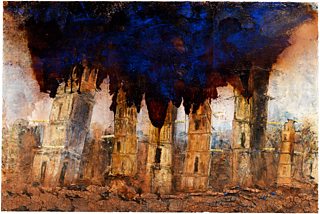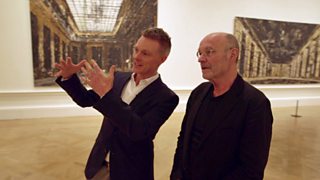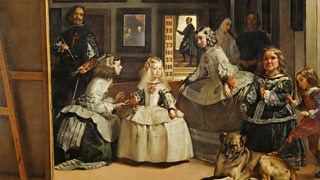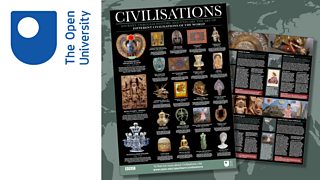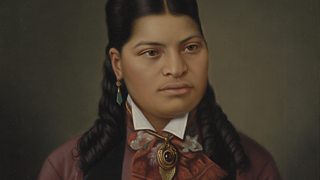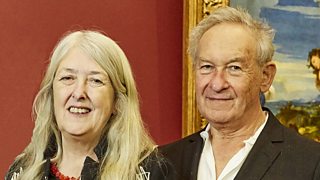Opening the wounds of history: Anselm Kiefer’s war on forgetting
25 April 2018
Anselm Kiefer has dedicated himself to confronting the haunting stories of Germany's Nazi past in his art. In episode nine of Civilisations: The Vital Spark, Simon Schama uses Kiefer’s work to illustrate "what art can do when horror comes calling, when civilisation itself is lost".
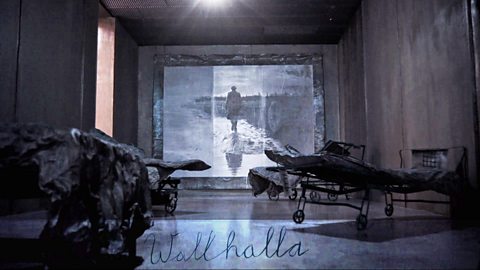
The influence of German history on the art of Anselm Kiefer
In Simon Schama's words, Kiefer's work wages his own war to keep the past from oblivion.
Satirical poses designed to pierce the conspiracy of forgettingSimon Schama
Although Anselm Kiefer was born in Germany just before the end of World War Two and grew up among bombed-out buildings, he learned little about the conflict during his childhood. The Third Reich merited just a few weeks of study while he was at school.
But Kiefer discovered a record, distributed by Americans to re-educate the Germans about the war, while he was at art school. Its recordings of the voice of Hitler and other key figures of the Nazi regime "so repelled and fascinated" the aspiring artist that he felt compelled to fully research his country's history.
Kiefer’s first major work was 1969's Occupations: a series of still controversial photographs depicting the artist in his father’s military uniform and performing the Nazi salute, a gesture banned in Germany since 1945. Kiefer visited places across Europe that had experienced blitzkrieg operations by the Panzer divisions of the German armed forces, and captured himself saluting the scenery.
For Simon Schama this combination of performance and photography create "satirical poses designed to pierce the conspiracy of forgetting, a wound-opener".
Kiefer's Occupations
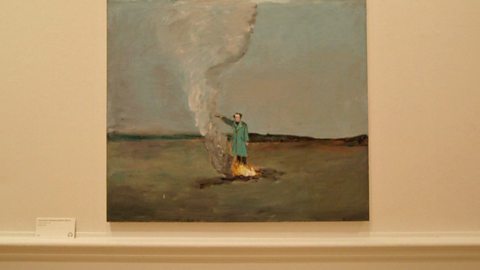
Anselm Kiefer on using the Nazi salute in his art
The German artist discusses his work with Tim Marlow at the Royal Academy.
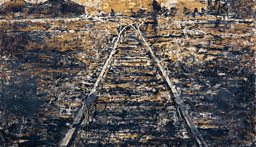
The vanishing point of perspective is also a vanishing place for people.Simon Schama
The 'salute' photographs were just the start of Kiefer’s artistic relationship with World War Two. His large-scale paintings, often featuring molten metal as well as natural materials, depict blasted cities and bleak railways reaching into the horizon.
Schama says, “his vast landscapes are often soiled and smoking. On them he lays down fateful railway lines stretching away into a remote distance, where the vanishing point of perspective is also a vanishing place for people.”
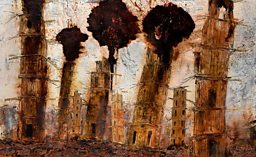
Kiefer’s 2016 painting Böse Blumen shows a series of high towers in a desolate landscape, their tops bursting into black smoke. Looking closely at the painting, Schama notes: “There are names written in Kiefer's spidery hand. Great figures of all the Germanic peoples from history, culture, art. Painters like Dürer, generals like Wallenstein, an indiscriminate gathering of both the gifted and the dangerous.”
These are among the people honoured in a building which sought to make physical a sense of German national identity - the Walhalla. This bombastic mausoleum was commissioned by Ludwig I, King of Bavaria; located east of Regensberg, the vast neoclassical structure was completed in 1842.
For the Walhalla, Ludwig germanised the Norse concept of Valhalla, a final resting place for great warriors killed in battle. He filled it with portrait busts of heroes of German culture. In the 1930s, Schama says, it became “a place of cultural pilgrimage for all good Nazis”.


Kiefer's work seems to share the historian's version of the Hippocratic Oath, to wage war against forgetfulness.Simon Schama
Kiefer used the name Walhalla for a major exhibition which opened in London in November 2016. It featured a dormitory reminiscent of a hospital ward with empty, unmade beds created entirely of lead, as well as large-scale landscape paintings and sculptures made from refuse such as ragged old clothes and rusty bicycles.
Art writer William Cook found echoes of World War Two in his work: "Kiefer’s paintings evoke the barren landscapes of bombed-out cities. His sculptures evoke the horrors of the concentration camps. Yet although his work is harrowing, like all great art it is exhilarating – even when the subject matter is so bleak."
For Schama, Anselm Kiefer's ability to keep the past present in our minds is his great power: "I've always been moved by Kiefer's work because it seems to share the historian's version of the Hippocratic Oath, to wage war against forgetfulness."
Anselm Kiefer exhibitions
-
![]()
Walhalla at White Cube
This 2016 exhibition featured a lead-lined dormitory and paintings covered in molten metal.
-
![]()
Kiefer at The Royal Acadamy
The first major British retrospective of the work of Anselm Kiefer.
More from Civilisations
-
![]()
Hue knew? Five surprising facts about colour
Colour is a complicated and, at times, controversial topic.
-
![]()
Explore masterpieces of European painting
Five of the most significant paintings in the history of Western art.
-
![]()
Order a free poster from the Open University
OpenLearn, the OU’s home of free learning, helps you explore the art of different civilisations of the world.
-
![]()
Digital innovations
Explore artefacts using the augmented Reality (AR) app and 360 degrees videos, plus storytelling collaborations with UK museums and galleries.
-
![]()
The Czech and the Chieftains
How the Māori community turned the tables on colonial art.
-
![]()
9 fascinating facts from The Civilisations Podcast
Viv Jones' audio companion to the BBC Two series is taking us on some intriguing tangents.
-
![]()
The Inside Story
Mary Beard and Simon Schama reveal the inside story of writing and presenting the BBC Two series Civilisations.
-
![]()
Civilisations: Box set
Watch all nine episodes of the series on BBC iPlayer.
